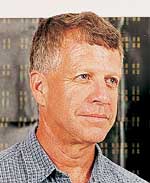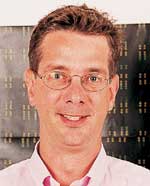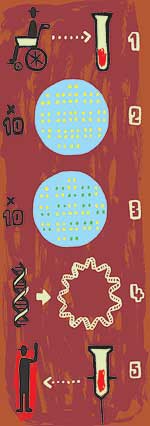 |
|
Autoantigen microarrays pave the way for patient-specific therapy. |
|
Mission: Translational
Patient-specific treatment for Autoimmune diseases might soon be reality
Linley Erin Hall
Photographs Trujillo/Paumier
Bill Robinson, MD, PhD, knows that there must be a better way to treat his patients who have autoimmune diseases. Currently doctors use harsh chemicals to knock out the patient's entire immune system when it goes haywire and begins attacking native tissue instead of foreign invaders. These treatments make patients more susceptible to infection and cancer and often do little to relieve symptoms. "We poison them. It's a barbaric way to treat autoimmune disease," says Robinson, a Stanford rheumatology fellow.
But right now, it's the only option for the 50 million Americans suffering from autoimmune diseases. A therapy that shuts down only the patient's specific immune response to native tissue would be gentler and more effective. But that requires a quick way to determine the specific proteins triggering the attack. These autoantigens might be only two or three proteins out of hundreds of candidates. A group of researchers at Stanford, including Robinson, has been working on both sides of the equation: developing an autoantigen screening device and a patient-specific therapy. Their results are so promising that they have formed their own company to take this treatment from the lab to the clinic.
 |
|
Bill Robinson, MD, PhD, seeker of gentler autoimmune disease therapies |
|
Robinson has been thinking for years about how to improve autoimmune disease treatment. During his residency at UC-San Francisco, he started working with a biotechnology company to design a device to detect the autoantigens provoking patients' autoimmune attacks. But, overwhelmed by clinical work, he left the project. At the same time, down at Stanford, neurology professor Lawrence Steinman, MD, was developing a targeted treatment for autoimmune diseases.
Steinman's strategy emerged unexpectedly from his efforts to find a new way to induce autoimmune disease in his laboratory mice. The technique was inspired by the work of other researchers, who had found that injecting mice with DNA coding for a flu protein vaccinated them against influenza. So Steinman injected mice with DNA encoding a protein that's attacked in the rodent version of multiple sclerosis. Instead of spurring disease, however, the DNA vaccine thwarted it.
"We turned what was good for infection upside-down and made it good for autoimmune diseases," Steinman says. Further experiments showed that some DNA vaccines could reverse disease. But within each autoimmune disease, the immune system might attack many different proteins. Steinman needed an efficient way to determine just which proteins each patient's immune system targeted.
In 1998 Robinson returned to Stanford where he had attended medical school. He began working in Steinman's lab and, realizing the potential of DNA vaccines, again tried to create autoantigen screening devices, using nylon membranes to carry the antigens. Then he became intrigued by work happening down the hall. Biochemistry professor Pat Brown, MD, PhD, had already made a splash with his invention of the DNA microarray, a glass slide with thousands of different DNA molecules on it. Now Brown's group was starting to make arrays containing proteins instead of DNA. Robinson learned how to make arrays and began to develop new protocols for protein arrays comprised entirely of autoantigens.
 |
|
Larry Steinman, MD, developer of autoimmune disease treatments |
|
Microarray fabrication begins with glass microscope slides coated with poly-L lysine, a polymer that provides a positively charged surface to which autoantigens stick. Researchers load these onto a robotic arrayer that spots the slide with miniscule amounts of different autoantigens. A rheumatoid arthritis array, for example, includes a wide variety of joint proteins; an autoimmune diabetes array focuses on pancreatic proteins.
Onto a finished array a researcher drops a tiny amount of blood serum – about the volume of ink on a pen tip. The serum contains autoantibodies, molecules the immune system uses to mark native proteins for destruction. It takes about an hour for the autoantibodies to attach to their target autoantigens. Then a researcher adds a drop of a fluorescent compound that binds to all human autoantibodies. When the microarray is placed in a scanner half an hour later, the spots corresponding to the autoantigens in the disease glow.
After Robinson and Steinman had been printing crude arrays for about six months, P.J. Utz, MD, another Stanford School of Medicine graduate, returned as an assistant professor and autoantibody expert. He quickly began collaborating with Steinman and Robinson, providing more autoantigens to include in arrays and human serum samples on which to test the arrays. He also changed his lab's focus from biochemistry and cell biology to translational medicine. " 'Bench-to-bedside' research isn't promoted at many other places," Utz says. "But the whole philosophy here at Stanford is to transform basic science into therapeutics."
Focus on the Patient
Autoantigen microarrays could speed up the diagnosis of autoimmune diseases manyfold. Current tools test each autoantigen individually, and getting the results may take weeks. Robinson can analyze 30 microarrays, each containing thousands of proteins, in less than 48 hours; he predicts an automated system could return results in three or four hours. Doctors can also follow a patient's response to therapy using microarrays; treatment should reduce the number of autoantibodies in the patient's serum. Back in the lab, microarrays could also help researchers discover new autoantigens – the specific proteins targeted in inflammatory bowel disease, the skin disease psoriasis and many other autoimmune diseases, which are still unknown.
 |
|
P.J. Utz, MD, translational medicine zealot and autoantibody expert |
|
But the greatest benefit of autoantigen microarrays is their potential to facilitate disease- and patient-specific treatments. The arrays can be paired with many different therapies in development, but Utz, Steinman and Robinson focus on DNA vaccines. Once the array reveals the targeted autoantigens, researchers can easily obtain or make the DNA that codes for each protein. They insert these pieces into rings of DNA called plasmids. Researchers make a cocktail of these plasmids, one for each autoantigen, and inject it into the patient. They are still studying how it works, but injecting the DNA makes the immune system more tolerant of the protein encoded by the plasmid, especially when co-injected with DNA for immune system proteins. In animal models of multiple sclerosis and autoimmune diabetes, such DNA "tolerizing" vaccines reverse established disease.
The group calls its strategy "reverse genomics." Normally DNA supplies the information cells need to make proteins; but these scientists use information from proteins identified using autoantigen microarrays to create DNA-based therapy. Because of their success with animal models in the lab, the researchers had a hunch they were onto something. But moving a promising treatment through clinical trials to market requires hundreds of millions of dollars. No researcher will ever receive such sums from the National Institutes of Health, Steinman says. But NIH does have the right to commercialize an invention developed with its grant money if the researchers do not.
Not wanting to lose control of DNA tolerizing vaccine technology, Steinman, Robinson, Utz and Hideki Garren, MD, PhD, a former fellow in Steinman's lab, decided to work with Stanford's Office of Technology Licensing to license the vaccines to an established company or to start their own. They tried to interest biotechnology firms, but, as Utz says, "they all wanted too big a piece of the pie, and they did not fully understand the impact of what could happen if we succeeded."
Steinman had already started one company. Building on his experience, the four men founded their own company, Tolerion, where Garren is now the lead scientific director. "The people who discover and develop a therapy really need to be guiding the whole process," Robinson says. "We can't actually run the clinical trials, but we can choose appropriate endpoints, set doses and make sure the trials are run well." Phase-I clinical trials of a generalized DNA tolerizing vaccine will begin in about a year.
Autoantigen screening tool: coming soon?
The researchers continue to improve their autoantigen microarrays, but the technology is still a "bench" rather than a "bedside" technique. The autoantigens on the microarrays come from labs around the world, and obtaining the rights to use each one commercially is an expensive proposition. Data analysis on each microarray is also slow. Robinson hopes that a large company will commercialize such a technology, and many biotech firms are developing autoantigen screening methods. "There are a lot of smart people with great technology out there, but if they aren't asking the right questions, it's useless," Utz says. "A clinician-scientist is in the best position."
The road from bedside to bench and back is a long one, but these researchers agree the journey is worthwhile. "I'm a better scientist," says Robinson. "I think about problems differently than if I hadn't faced the challenges of real-world drug development." Adds Utz, "If I can contribute to just one discovery that changes how we treat patients, then I am satisfied."
 |
|
Illustration by Brian Cairns |
|
Custom Therapy
-
Take a blood sample from a patient with an autoimmune disease.
-
Place a drop of blood serum on the autoantigen microarray. Autoantibodies in the serum stick to specific autoantigens.
-
Add a drop of a glowing compound that sticks to all autoantibodies. As a result, autoantigens involved in the patient's disease glow too.
-
Insert the DNA that corresponds to these autoantigens into rings of DNA called plasmids.
-
Use the plasmids as a DNA vaccine.
To startup or not to startup, that is the question
Researchers who want to move their innovations from lab to clinic have two options: to start their own company or to license the technology to an established firm. The best route depends on the technology and the researchers.
Advantages for researchers who start a company
-
More control over the process
-
Certainty that their innovation won't sit on a shelf while other ideas are pursued
-
Great flexibility to develop and market a new type of therapy
-
Potential for greater financial gain than alternatives
Advantages of licensing the innovation to an established firm
-
Frees researchers from the need to raise funds, establish and run a company and oversee logistics of clinical trials
-
Minimizes the challenge of avoiding real or perceived conflicts of interest
Comments? Contact Stanford Medicine at

